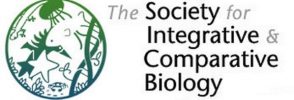Contents
Message from the Chair
John Long, chair.dcb@sicb.org
With the end of this year’s remote annual meeting, we say, “Farewell and welcome!” Leaving us in her role as Chair of the Division is Stacey Combes, who gave us excellent leadership for two years. Please join me in thanking her. Fortunately for us, she can’t be entirely free of DCB yet: she will continue to advise us as the Past Chair. Joining the Division’s Executive Committee is the Chair-Elect, Brooke Flammang, winner of the 2020 election for that position. Welcome! After observing from the wings, she will take the reins in two years.
With elections in mind, this Spring we’ll elect a new divisional Program Officer and Secretary. Many thanks to our Nominating Committee, David Hu (chair), Kakani Katija, and Marianne Porter. They considered self-nominations – which are always encouraged – and also generated a separate list of nominees from the DCB membership list. We are very grateful to the following candidates for accepting the nomination: Mason Dean and Jimmy Liao for Program Officer; Maria Laura Habegger and Floris van Breugel for Secretary. Please read their biographies, below.
Both positions are extremely important, with much hidden work behind the scenes. As indicated in our divisional bylaws, the main job of the Program Officer is to “arrange for the programs” of the division. Sounds simple until you have to solve that puzzle at the same time that all the other divisional program officers are solving theirs while considering available rooms, proximity to related talks, and the always vexing overlap of sessions. The main job of the Secretary is, frankly, to keep the Division running. They organize communications, produce and edit the newsletter, and manage nomination committees and nominees. This is critical service to our division and we thank the candidates for standing for election.
We are seeking volunteers to form this year’s Gans Award Nomination Committee. With nominations due usually in mid-August, the work of the committee takes place shortly thereafter. Please email me if you are interested in either being on the committee, nominating someone, or self-nominating. Details about the award and nomination process are found here.
Thanks to all members for pulling together to make the SICB 2021 Annual Meeting work. I want to give a special thanks to Armita Manafzadeh, our Student and Postdoctoral Representative, who innovated and organized to make our two joint DCB-DVM Socials a great success. Also, Matt McHenry, our Program Officer, worked the scheduling puzzle I mentioned, above, under very fluid conditions throughout the fall. Finally, a personal thanks to our Secretary, Emily Kane, for a steady hand on the tiller, keeping us on course in the face of headwinds and rough seas.
Carl Gans Award: Keynote Address at SICB 2021
Dr. Martha Muñoz, winner of the 2021 Carl Gans Award, gave the keynote address, ‘Constraint’, a Double-edged Sword for Evolution. A faculty member at Yale University (www.marthamunoz.com/), Dr. Muñoz’s work is a great example of the approach to biomechanics that Dr. Gans championed: comparative, ecological, and evolutionary.
Congrats to Dr. Muñoz, and thanks to Twitter user Hugo A. Benítez, @HugoBenitezd, for capturing this screenshot featuring both Martha (right) and DCB chair Stacey Combes (left).
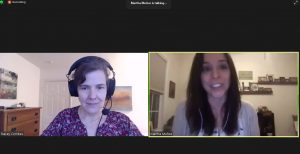
Each year, DCB evaluates applications for the Carl Gans Award, which was established to recognize Carl Gans’ contributions to animal morphology, biomechanics, and functional biology. The Gans Award is given to (1) an outstanding young investigator in the field of comparative biomechanics and/or (2) an investigator at any career stage for a significant contribution to the literature of comparative biomechanics published in the preceding five calendar years.
The awardee receives a commemorative plaque at SICB, reimbursement for travel expenses to the meeting, and the honor of joining the ranks of past Carl Gans Awardees, such as Martha Muñoz, Alyssa Stark, Misty Paig-Tran, Brooke Flammang, Sharlene Santana, Chris Clark, and Eric Tytell. We would love to see more members of our growing, vibrant DCB community included in the nominee pool for this award, so please think about submitting an application or nominating one of your colleagues! Additional details about the Gans award are available at: http://sicb.org/membership/awards.php3#gans.
Congratulations to the DCB Best Student Presentation Award winner!
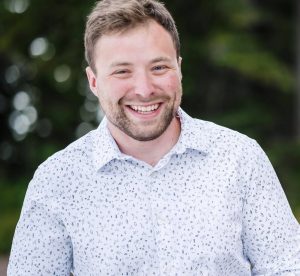
The best student presentation competition offered a remarkable glimpse into the up-and-coming research of the graduate students in our division. Finalists were chosen from a larger pool of students who submitted extended abstracts in September, and all of the finalists presented fascinating work. We would like to thank the DCB BSP committee for their impeccable organization and the time they dedicated to this year’s competition. We are already looking forward to hearing from next year’s new talent.
This year’s winner of The Mimi A. R. Koehl and Stephen A. Wainwright Award for the Best Student Talk in Biomechanics was Anthony Lapsansky from the University of Montana, with his talk titled: Aquatic locomotion in non-aquatic birds and the secondary evolution of subsurface swimming.
Tribute to Steve Wainwright
Many members of DCB were deeply saddened to hear of Steve Wainwright’s passing last year. Mark Westneat and I have compiled a tribute to Steve, with many current DCB members contributing. Please click here to read about Steve’s impact on so many of us.
If you are interested in honoring Steve by supporting graduate students through SICB’s Grants-in-Aid of Research (GIAR) program, we invite you to contribute to the Stephen Wainwright named fund.
Message from the Program Officer
Matt McHenry dpo.dcb@sicb.org
Despite the many challenges faced by our membership over the past year, the SICB leadership achieved a major feat by organizing an annual meeting with more registrations than any in recent years prior. As is typical of our meetings, DCB and DVM played a disproportionately large role in the symposia and contributed sessions. About one-fifth of contributed talks were within session organized by our divisions and we sponsored half of the symposia.
SICB 2021 looked a little different this year, but the new format made it one of our most accessible meetings – even pets had a chance to join! Image by Twitter user Ben Tidswell, @BenKTidswell, who posted: “I wasn’t the only one interested in Anthony Lapsansky’s talk about the aquatic locomotion of birds!”.
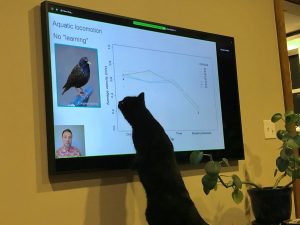
Symposia
Symposia are vital to the division and the society in general. They serve to highlight major themes in our field, provide perspectives from outside the society, and serve as a basis for influential published volumes of Integrative and Comparative Biology (ICB). Through a strong history of divisional leadership, we are on a streak of supporting excellent symposia. The symposium talks at the virtual meeting covered an impressive diversity of topics, including how to teach with experiential learning, the integrative biology of dogs, the diversity of biological adhesives, the fluid-structure interactions of swimming appendages, and the mechanics of behavior.
We are on track to continue supporting diverse and interesting symposia at the upcoming meeting in Phoenix. Here are the topics that DCB is sponsoring for SICB 2022:
- Lesser known transitions: organismal form and function across abiotic gradients. Organizers: Charlotte Easterling, Mary Kate O’Donnell, & Matthew Kolmann
- Open source solutions in experimental design. Organizers: Kirk Onthank & Richelle Tanner
- Causal mechanisms of interspecific metabolic scaling patterns. Organizers: Jon Harrison & Meghan Duell
- Evolutionary conservation and diversity in a key vertebrate behavior: “walking” as a model system. Organizers: Haley Amplo, Alice Gibb, & Sandy Kawano
- Best practices for bioinspired design education, research and product development. Organizers: Marianne Alleyne, Aimy Wissa, Andrew Suarez, & William Barley.
- Reciprocal illumination between ecology and biomechanics: evolution, integration, and constraint. Organizers: Lara Ferry & Tim Higham.
Maintaining strong DCB symposia depends on the creative energy of our members. As a former organizer myself, I can say that it is highly rewarding to gather a group of speakers whom you admire and to later see that work in a published volume of ICB. So, please consider organizing a symposium for SICB 2023 in Austin, TX. The deadline for a symposium proposal will be in August, though you will want to start planning soon. If you have some potential ideas, then do not hesitate to contact me with your thoughts (dpo.dcb@sicb.org). Here are some guidelines for what’s involved when organizing a symposium: https://tinyurl.com/tkudwnr.
Once SICB members have submitted their symposium ideas, then I will be involved with deciding which ones to approve and grant DCB support. Please help guide me through this process by taking about one minute to fill out the following survey, which indicates the kind of symposium that you would like to attend or maybe organize yourself: https://forms.gle/WYgWamNE9ACLrfBL6
Contributed presentations
The large numbers of DVM/DCB contributions offer an embarrassment of riches for those of us who enjoy a variety of topics related to biomechanics. Nonetheless, I think we still have room for growth and I would therefore recommend that we all encourage abstract submission by biologists and engineers who have either gotten out of the habit of attending or would enjoy an introduction to our community.
You can help yourself get assigned to a session with speakers who share your interests. When you submit an abstract for the meeting, select your primary topic under the general subject of Category B: ‘Morphology and Biomechanics’. Presentations under that classification should cross my desk when we put the program together.
Finally, I have to offer my immense gratitude to Jake Socha, the society Program Officer (and DCB member) for all of his hard work in reorganizing how we run a meeting for the virtual format. I also was greatly helped by Mason Dean, the DPO for DVM, who did much of the organizing the DCB and DVM sessions. My job was largely facilitated by Jake and Mason’s hard work.
Message from the Secretary
Emily Kane secretary.dcb@sicb.org
Just a few quick updates from me:
Member’s Meeting minutes
Please review our 2021 Member’s Meeting minutes (here). We will vote on their approval at the 2022 Member’s Meeting next year, so let me know if you have any questions or concerns about them.
Elections
This Spring we are electing a new Program Officer and Secretary of the Division of Comparative Biomechanics, who will each serve from January 2022 through the end of the annual meeting in January 2023. You can read each candidates’ biography at the end of this newsletter. We thank the candidates for their willingness to serve, as well as the Nominating Committee (Drs. David Hu, Kakani Katija, and Marianne Porter) for helping us assemble such a stellar list of candidates! We especially encourage student and post-doc members to vote – start shaping the future of your society now! Note that you do NOT need to have already paid your 2021 dues to vote – having attended the 2021 virtual meeting (or being a member in 2020) qualifies you to vote in the spring 2021 elections.
We need volunteers!
You don’t have to be a divisional officer to contribute to DCB! We will be soliciting volunteers to serve on the following committees in 2021. Volunteers should be DCB members with full status.
- 2022 Gans Award Committee: Consider the diverse needs and representation of our members to suggest nominations for potential candidates. While anyone can nominate candidates, the committee will be responsible for ensuring the candidates are representative of our members and will nominate additional candidates if necessary. The committee will also judge applications and decide an awardee. TIMELINE: Aug-Sep 2022
- 2022 Election Nominating Committee: Consider the diverse needs and representation of our members to suggest nominations for the upcoming Chair-Elect election. While anyone can nominate candidates, the committee will be responsible for ensuring the candidates are representative of our members and will nominate additional candidates if necessary. The committee will narrow the nominations to 2-3 candidates. TIMELINE: Chair needed by October 2021, additional members needed by end of year, nominations chosen and nominee acceptance by end of January 2022 at the latest.
National Biomechanics Day
National Biomechanics Day is a world-wide celebration of all things Biomechanics for high school students and teachers. This is a great opportunity to showcase comparative biomechanics as a fun and engaging field of study and a potential career pathway for students. The official date was April 7, 2021, but events can be held any spring or early summer day that works best for you. If you plan on hosting an event, you are asked to register your lab, which can be done here. If you do host or participate in an event, let DCB know! We love to highlight our members!
Steven Vogel Young Investigator Award
The Bioinspiration & Biomimetics journal began the Steve Vogel Young Investigator Award in 2017 to recognize the contributions of early career researchers (within 10 years of PhD) in the fields of biomechanics and biomimetics. Consider nominating colleagues (self-nominations are excluded), especially those who have not yet received this type of recognition for their work. The deadline for nominations is May 31, 2021.
Members in the Media!
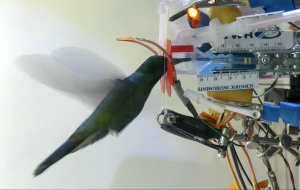
DCB member Dr. Alejandro Rico-Guevara (University of Washington, Seattle, twitter: @ecophysicslab) recently had his work on hummingbird respirometry featured in the Netflix series Alien Worlds (Episode 3, Eden)!
Message from the Student and Postdoctoral Representative:
Armita Manafzadeh armita@brown.edu
It was great to see so many of you at the virtual annual meeting!
As always — students and postdocs, please feel free to contact me by email or Twitter (@armanafzadeh) with your suggestions, comments, concerns, or SICB-related feedback, and I’ll be happy to pass them along to John, Matt, and Emily. I am happy to anonymize your feedback if you’d like.
In addition to my work with our students and postdocs, I also run our joint DCB/DVM Twitter account (@SICB_DCB_DVM) and our Facebook group. Please tag @SICB_DCB_DVM in any tweets you’d like me to signal boost — but if you’re not on social media, I’m still happy to share your announcements with our members who are! Our social media channels can be a great place to advertise open positions, share your latest publications, or seek help from the community. Feel free to email me with anything you’d like me to post.
Finally, I run a ~biweekly Twitter #featureFriday series to highlight our wonderful members! This is an easy way to make others in the community aware of you and your work, especially for our early career members. If you’re interested in being featured, please fill out my survey at tinyurl.com/dcbdvmsurvey. PIs, please encourage your students/postdocs to show themselves off!
I’m looking forward to seeing you all again (hopefully in person) soon!
Candidates for Program Officer
Mason Dean
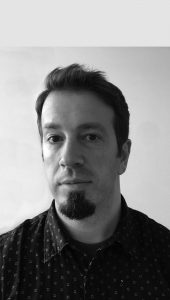
Current Position: Asst. Professor, Department of Zoology, Trinity College Dublin, Ireland; Guest Scientist, Department of Biomaterials, Max Planck Institute of Colloids & Interfaces, Germany; Associate Investigator, Matters of Activity: Image Space Material, Excellence Cluster of Humboldt University Berlin, Germany
Education: Ph.D., Ecology and Evolutionary Biology, UC Irvine (2009; Advisor: Adam Summers); M.S., Zoology, University of South Florida (2003; Advisor: Philip Motta); A.B., Biology w/ Marine Biology concentration, Duke University (2007; Advisor: Richard Forward)
Professional Experience: Following a Humboldt Post-doctoral Fellowship in Germany at the Max Planck Institute, I established a workgroup there, first funded by a Human Frontier Science Program grant, then by the Max Planck Society. After working in Germany for 11 years, I have recently started a workgroup in the Department of Zoology at Trinity College in Dublin, Ireland. Relevant to the DPO position, I’ve served as DPO for DVM, have organized seven externally-funded symposia in disparate fields (e.g. biomaterials, feeding mechanics, and biomineralization), and co-founded an international conference on Comparative Cartilage Biology in 2019.
SICB Activities: Full Member; regular attendee of SICB since 1999; DVM Program officer (2019-2021); DVM Nominating Committee member (2007-10, 2017); co-organizer of two symposia (2009, 2019); session leader and BSP judge (since 2002); Dwight D. Davis presentation award winner as a student
Other Memberships: Society of Experimental Biology (SEB), European Calcified Tissue Society (ECTS), German Zoological Society (DZG)
Research Interests: Collaborative approaches integrating science, technology, engineering, art and mathematics
Goals statement: I’d be excited to give back to DCB as DPO — I’ve been a member of DCB for years and have gotten so much from its science and the friendships I’ve built here. I’m just finishing a tenure as DVM’s DPO: two years is just enough time to learn how to keep the ship afloat, but not quite enough to make real change. With Phil and Matt (previous and current DCB DPOs), I’ve been working to streamline and document the DPO’s duties, to reduce the scramble when a new DPO starts and allow more focus on moving science and mentorship forward. I want to keep pushing divisional and disciplinary boundaries by actively soliciting cutting-edge and diverse symposia, particularly organized by (and including) young-career scientists. I also love to help the division strengthen its ties to varied international societies (e.g. SEB, ECTS) — this will grow DCB and the society’s journal, while also building bridges to other fields interested in biomechanics (engineering, materials science, robotics). Being forward-thinking and open will keep us aware of relevant, state-of-the-art work in other disciplines, while opening communication for novel collaborations and networking/training opportunities for DCB students.
Jimmy Liao
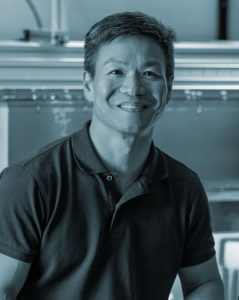
Current Position: Associate Professor of Biology, University of Florida and The Whitney Laboratory for Marine Bioscience.
Education: Ph.D. Biology, Harvard University (2004), M.A. Biology, Harvard University (2003), B.A. Biology magna cum laude, Wesleyan University (1996).
Professional Experience: Assistant/Associate Professor of Biology at the University of Florida/The Whitney Laboratory for Marine Bioscience, Affiliate Professor, J. Crayton Pruitt Family of Biomedical Engineering, Affiliate Assistant Curator of Ichthyology, Florida Museum of Natural History (2009-present); NIH NRSA Postdoctoral Fellow, Dept. of Neurobiology and Behavior, Cornell University (2004-2007); Visiting Research Faculty, Undergraduate and Graduate Tropical Field Biology, Organization for Tropical Studies (2000-2012).
SICB Activities: Member since 1998. Judge, student awards in Divisions of Comparative Biomechanics, Vertebrate Morphology, and Neurobiology (2005-2014). Public Affairs Committee (2017-2020).
Other Memberships: Society for Experimental Biology, American Society of Ichthyologists and Herpetologists, International Society for Neuroethology, Society for Neuroscience.
Research Interests: My research looks through the lens of biomechanics and neuroscience to better understand fish behavior across multiple levels of organization, from single neurons to the organism. Current approaches include 1) using zebrafish and cavefish to understand the interactions between sensory and motor function, and 2) combining brain and muscle recordings in virtual reality arenas to investigate the role of perception on predator-prey responses, and 3) leveraging field tagging technologies to understand the diversity and magnitude of natural behaviors.
Goals Statement: I’m excited to work with other divisional Program Officers to organize an inclusive cross-section of talks and poster for the annual meeting. As a member of the Diversity, Equity and Inclusion Committee at my home institution, one of my priorities is to enable scientists from non-traditional backgrounds to bring in their perspectives to expand the intellectual reach of comparative biomechanics. To paraphrase a Taiwanese saying, “the ocean only gets so big because it accepts all sources of water.”
Candidates for Secretary
Maria Laura Habegger
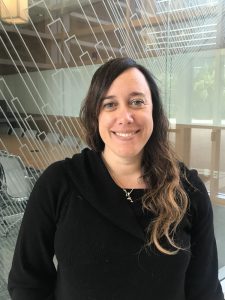
Current Position: Assistant Professor, Biology Department at the University of North Florida
Education: BS in Aquatic Biology (Universidad de Buenos Aires), MS and PhD in Biology (University of South Florida)
Professional Experience: 2015-2016: Ichthyology Collection Manager, Florida Fish and Wildlife Research Institute (FWRI); 2015-2016: Adjunct instructor (USF); 2016- 2019: Assistant Professor (Florida Southern College); 2019-present: Assistant Professor (University of North Florida)
SICB Activities: Active member (presented my research most years since 2008)
Other Memberships: ICVM and JMIH
Research Interests: Functional morphology and feeding biomechanics in fishes
Goals Statement: My goals as secretary for the Division of Comparative Biomechanics at SICB are tightly related to my deep desire to give back to this prestigious association. As an international graduate student (Latina) SICB has opened its doors for me and supported my research immensely giving me each January an energizing stimulus that boosted my progress and shaped my research interests. The high quality and truly interdisciplinary level of research shown at SICB rises every year and I want to be an active part of this ever-growing outstanding intellectual chain. During my service I will be honored to contribute to the growth of knowledge and diversity of this one of a kind community of broad-minded scientists where we all share SICB’s common goal to foster research and education about all living organisms.
Floris van Breugel
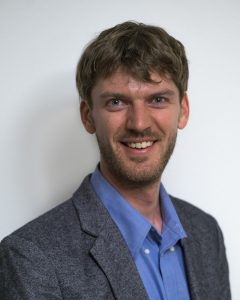
Current Position: Assistant Professor, Dept. of Mechanical Engineering and Programs for Integrative Neuroscience and Ecology & Evolution, University of Nevada, Reno.
Education: PhD in Control and Dynamical Systems, Caltech (2014; Advisor: Michael Dickinson). BS in Biological Engineering, Cornell University.
Professional Experience: Assistant Professor, University of Nevada – Reno (2019-present), Postdoctoral fellow in Biology and Data Science, University of Washington (2017-2019; Advisors: Jeff Riffell, Nathan Kutz), Postdoctoral Fellow in Biology, Caltech (2015-2017; Advisor: Michael Dickinson).
SICB Activities: Member and regular attendee since 2012.
Other Memberships: American Physical Society, co-organized workshop on Robotics-Inspired-Biology at IROS 2020
Research Interests: I study how animal movement and sensory processing are coupled, and how their coevolution is shaped by ecology. I am especially interested in how insects integrate different types of sensory information over time to solve complex problems in dynamic environments, like odor plume tracking, using flies and robots as model systems. These are inherently integrative research questions, and my lab takes an interdisciplinary approach that brings together biomechanics, behavior, neurobiology, and robotics.
Goals Statement: The process of starting a lab that straddles several departments and programs in the midst of a global pandemic has made it clear to me how important it is to have a supportive community of peers and colleagues with similar academic interests. Regular sharing of ideas within this community is needed for both academic and emotional support. SICB, and in particular DCB, has been the most constant and supportive community in my own academic career, and my experience over the past two years has given me the motivation to start giving back. As Secretary, I will continue with the efforts of my predecessors to keep our unique community strong and welcoming. In particular, I will use the newsletter and other social media avenues as an opportunity to help students, postdocs, early-career, and established faculty make connections that extend beyond our annual meeting by encouraging the organization and advertising of opportunities for seminars, regional gatherings, and workshops related to comparative biomechanics throughout the year.
